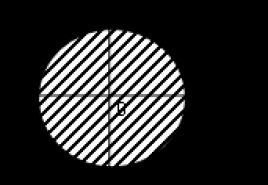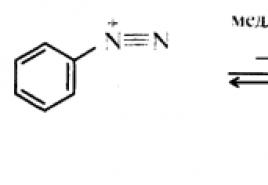The rate of chemical reactions and the factors on which it depends: the nature of the reacting substances, their concentration, the temperature of the chemical reactions, the contact surface of the reacting substances, catalysts. Rate of chemical reaction: conditions, at
Kinetics– the science of the rates of chemical reactions.
Chemical reaction rate– the number of elementary acts of chemical interaction occurring per unit time per unit volume (homogeneous) or per unit surface (heterogeneous).
True reaction speed:
2. Factors affecting the rate of a chemical reaction
For homogeneous, heterogeneous reactions:
1) concentration of reacting substances;
2) temperature;
3) catalyst;
4) inhibitor.
Only for heterogeneous:
1) the rate of supply of reacting substances to the phase interface;
2) surface area.
The main factor is the nature of the reactants - the nature of the bonds between atoms in the molecules of the reactants.
NO 2 – nitrogen oxide (IV) – fox tail, CO – carbon monoxide, carbon monoxide.
If they are oxidized with oxygen, then in the first case the reaction will occur instantly, as soon as you open the cap of the vessel, in the second case the reaction is extended over time.
The concentration of reactants will be discussed below.

Blue opalescence indicates the moment of sulfur precipitation; the higher the concentration, the higher the speed.

Rice. 10
The higher the concentration of Na 2 S 2 O 3, the less time the reaction takes. The graph (Fig. 10) shows a directly proportional relationship. The quantitative dependence of the reaction rate on the concentration of the reacting substances is expressed by the LMA (law of mass action), which states: the rate of a chemical reaction is directly proportional to the product of the concentrations of the reacting substances.
So, basic law of kinetics is an experimentally established law: the rate of a reaction is proportional to the concentration of the reactants, example: (i.e. for a reaction)

For this reaction H 2 + J 2 = 2HJ – the rate can be expressed in terms of a change in the concentration of any of the substances. If the reaction proceeds from left to right, then the concentration of H 2 and J 2 will decrease, and the concentration of HJ will increase as the reaction progresses. For the instantaneous reaction rate, we can write the expression:
square brackets indicate concentration.
Physical meaning k– molecules are in continuous motion, collide, fly apart, and hit the walls of the vessel. In order for the chemical reaction to form HJ to occur, the H2 and J2 molecules must collide. The number of such collisions will be greater, the more molecules of H 2 and J 2 are contained in the volume, i.e., the greater the values [H 2 ] and . But the molecules move at different speeds, and the total kinetic energy of the two colliding molecules will be different. If the fastest molecules H 2 and J 2 collide, their energy can be so high that the molecules break into atoms of iodine and hydrogen, which fly apart and then interact with other molecules H 2 + J 2 > 2H+2J, then H + J 2 > HJ + J. If the energy of the colliding molecules is less, but high enough to weaken the H – H and J – J bonds, the formation reaction of hydrogen iodide will occur:

For most colliding molecules, the energy is less than that required to weaken the bonds in H 2 and J 2. Such molecules will “quietly” collide and also “quietly” disperse, remaining what they were, H 2 and J 2. Thus, not all, but only part of the collisions lead to a chemical reaction. The proportionality coefficient (k) shows the number of effective collisions leading to a collision reaction at concentrations [H 2 ] = 1 mol. Magnitude k–const speed. How can speed be constant? Yes, the speed of uniform rectilinear motion is a constant vector quantity equal to the ratio of the movement of a body over any period of time to the value of this interval. But molecules move chaotically, then how can the speed be const? But a constant speed can only be at a constant temperature. With increasing temperature, the proportion of fast molecules whose collisions lead to a reaction increases, i.e., the rate constant increases. But the increase in the rate constant is not unlimited. At a certain temperature, the energy of the molecules will become so great that almost all collisions of the reactants will be effective. When two fast molecules collide, a reverse reaction will occur.

There will come a moment when the rates of formation of 2HJ from H 2 and J 2 and decomposition will be equal, but this is already a chemical equilibrium. The dependence of the reaction rate on the concentration of the reactants can be traced using the traditional reaction of interaction of a solution of sodium thiosulfate with a solution of sulfuric acid.
Na 2 S 2 O 3 + H 2 SO 4 = Na 2 SO 4 + H 2 S 2 O 3, (1)
H 2 S 2 O 3 = Sv+H 2 O+SO 2 ^. (2)
Reaction (1) occurs almost instantly. The rate of reaction (2) depends at a constant temperature on the concentration of the reactant H 2 S 2 O 3. This is exactly the reaction we observed - in this case, the speed is measured by the time from the beginning of the solutions to merge until the appearance of opalescence. In the article L. M. Kuznetsova The reaction of sodium thiosulfate with hydrochloric acid is described. She writes that when solutions are drained, opalescence (turbidity) occurs. But this statement by L.M. Kuznetsova is erroneous since opalescence and turbidity are two different things. Opalescence (from opal and Latin escentia– suffix meaning weak effect) – scattering of light by turbid media due to their optical inhomogeneity. Light Scattering– deviation of light rays propagating in a medium in all directions from the original direction. Colloidal particles are capable of scattering light (Tyndall-Faraday effect) - this explains opalescence, a slight turbidity of the colloidal solution. When carrying out this experiment, it is necessary to take into account the blue opalescence, and then the coagulation of the colloidal suspension of sulfur. The same density of the suspension is noted by the visible disappearance of any pattern (for example, a grid on the bottom of a cup) observed from above through the layer of solution. Time is counted using a stopwatch from the moment of draining.
Solutions of Na 2 S 2 O 3 x 5H 2 O and H 2 SO 4.
The first is prepared by dissolving 7.5 g of salt in 100 ml of H 2 O, which corresponds to a 0.3 M concentration. To prepare a solution of H 2 SO 4 of the same concentration, you need to measure 1.8 ml of H 2 SO 4 (k), ? = = 1.84 g/cm 3 and dissolve it in 120 ml of H 2 O. Pour the prepared Na 2 S 2 O 3 solution into three glasses: 60 ml in the first, 30 ml in the second, 10 ml in the third. Add 30 ml of distilled H 2 O to the second glass, and 50 ml to the third glass. Thus, in all three glasses there will be 60 ml of liquid, but in the first the salt concentration is conditionally = 1, in the second – ½, and in the third – 1/6. After the solutions have been prepared, pour 60 ml of H 2 SO 4 solution into the first glass with a salt solution and turn on the stopwatch, etc. Considering that the reaction rate decreases with dilution of the Na 2 S 2 O 3 solution, it can be determined as a quantity inversely proportional to time v = 1/? and construct a graph, plotting the concentration on the abscissa axis, and the reaction rate on the ordinate axis. The conclusion from this is that the reaction rate depends on the concentration of substances. The data obtained are listed in Table 3. This experiment can be performed using burettes, but this requires a lot of practice from the performer, because the graph may be incorrect.
Table 3
Speed and reaction time

The Guldberg-Waage law is confirmed - professor of chemistry Gulderg and young scientist Waage).
Let's consider the next factor - temperature.
As temperature increases, the rate of most chemical reactions increases. This dependence is described by Van't Hoff's rule: “For every 10 °C increase in temperature, the rate of chemical reactions increases by 2 to 4 times.”
Where ? – temperature coefficient showing how many times the reaction rate increases when the temperature increases by 10 °C;
v 1 – reaction rate at temperature t 1 ;
v 2 – reaction rate at temperature t2.
For example, a reaction at 50 °C takes two minutes, how long will it take for the process to complete at 70 °C if the temperature coefficient ? = 2?
t 1 = 120 s = 2 min; t 1 = 50 °C; t 2 = 70 °C.
Even a slight increase in temperature causes a sharp increase in the reaction rate of active collisions of the molecule. According to activation theory, only those molecules whose energy is greater than the average energy of molecules by a certain amount participate in the process. This excess energy is activation energy. Its physical meaning is the energy that is necessary for the active collision of molecules (rearrangement of orbitals). The number of active particles, and therefore the reaction rate, increases with temperature according to an exponential law, according to the Arrhenius equation, which reflects the dependence of the rate constant on temperature
Where A - Arrhenius proportionality coefficient;
k– Boltzmann's constant;
E A – activation energy;
R – gas constant;
T- temperature.
A catalyst is a substance that accelerates the rate of a reaction without being consumed.
Catalysis– the phenomenon of changing the reaction rate in the presence of a catalyst. There are homogeneous and heterogeneous catalysis. Homogeneous– if the reagents and the catalyst are in the same state of aggregation. Heterogeneous– if the reagents and catalyst are in different states of aggregation. About catalysis, see separately (further).
Inhibitor– a substance that slows down the rate of reaction.
The next factor is surface area. The larger the surface area of the reactant, the greater the speed. Let us consider, using an example, the effect of the degree of dispersion on the reaction rate.
CaCO 3 – marble. Dip the tiled marble into hydrochloric acid HCl, wait five minutes, it will dissolve completely.
Powdered marble - we will do the same procedure with it, it will dissolve in thirty seconds.
The equation for both processes is the same.
CaCO 3 (s) + HCl (g) = CaCl 2 (s) + H 2 O (l) + CO 2 (g) ^.
So, when adding powdered marble, the time is less than when adding slab marble, for the same mass.
With an increase in the interface surface, the rate of heterogeneous reactions increases.
One of the areas of physical chemistry, chemical kinetics, studies the rate of a chemical reaction and the conditions affecting its change. It also examines the mechanisms of these reactions and their thermodynamic validity. These studies are important not only for scientific purposes, but also for monitoring the interaction of components in reactors during the production of all kinds of substances.
The concept of speed in chemistry
The reaction rate is usually called a certain change in the concentrations of the compounds that entered the reaction (ΔC) per unit time (Δt). The mathematical formula for the rate of a chemical reaction is as follows:
ᴠ = ±ΔC/Δt.
The reaction rate is measured in mol/l∙s if it occurs throughout the entire volume (that is, the reaction is homogeneous) and in mol/m 2 ∙s if the interaction occurs on the surface separating the phases (that is, the reaction is heterogeneous). The “-” sign in the formula refers to changes in the concentrations of the initial reactants, and the “+” sign refers to changing concentrations of the products of the same reaction.
Examples of reactions at different rates
Chemical interactions can occur at different rates. Thus, the growth rate of stalactites, that is, the formation of calcium carbonate, is only 0.5 mm per 100 years. Some biochemical reactions occur slowly, such as photosynthesis and protein synthesis. Corrosion of metals occurs at a fairly low rate.
Medium speed can be used to describe reactions that require one to several hours. An example would be cooking, which involves the decomposition and transformation of compounds contained in foods. Synthesis of individual polymers requires heating the reaction mixture for a certain time.
An example of chemical reactions whose speed is quite high is neutralization reactions, the interaction of sodium bicarbonate with a solution of acetic acid, accompanied by the release of carbon dioxide. You can also mention the interaction of barium nitrate with sodium sulfate, in which the release of a precipitate of insoluble barium sulfate is observed.
A large number of reactions can occur at lightning speed and are accompanied by an explosion. A classic example is the interaction of potassium with water.

Factors affecting the rate of a chemical reaction
It is worth noting that the same substances can react with each other at different rates. For example, a mixture of gaseous oxygen and hydrogen may not show signs of interaction for quite a long time, but when the container is shaken or hit, the reaction becomes explosive. Therefore, chemical kinetics identifies certain factors that have the ability to influence the rate of a chemical reaction. These include:
- the nature of the interacting substances;
- concentration of reagents;
- temperature change;
- presence of a catalyst;
- pressure change (for gaseous substances);
- area of contact of substances (if we are talking about heterogeneous reactions).
Influence of the nature of the substance
Such a significant difference in the rates of chemical reactions is explained by different values of activation energy (Ea). It is understood as a certain excess amount of energy in comparison with its average value required by a molecule during a collision in order for a reaction to occur. It is measured in kJ/mol and values are usually in the range of 50-250.

It is generally accepted that if E a = 150 kJ/mol for any reaction, then at n. u. it practically does not leak. This energy is spent on overcoming repulsion between the molecules of substances and on weakening the bonds in the original substances. In other words, activation energy characterizes the strength of chemical bonds in substances. Based on the value of activation energy, you can preliminary estimate the rate of a chemical reaction:
- E a< 40, взаимодействие веществ происходят довольно быстро, поскольку почти все столкнове-ния частиц при-водят к их реакции;
- 40-<Е а <120, предполагается средняя реакция, поскольку эффективными будет лишь половина соударений молекул (например, реакция цинка с соляной кислотой);
- E a >120, only a very small part of particle collisions will lead to a reaction, and its speed will be low.
Effect of concentration
The dependence of the reaction rate on concentration is most accurately characterized by the law of mass action (LMA), which states:
The rate of a chemical reaction is directly proportional to the product of the concentrations of the reacting substances, the values of which are taken in powers corresponding to their stoichiometric coefficients.
This law is suitable for elementary one-stage reactions, or any stage of the interaction of substances characterized by a complex mechanism.
If you need to determine the rate of a chemical reaction, the equation of which can be conditionally written as:
αA+ bB = ϲС, then
in accordance with the above formulation of the law, the speed can be found using the equation:
V=k·[A] a ·[B] b , where
a and b are stoichiometric coefficients,
[A] and [B] are the concentrations of the starting compounds,
k is the rate constant of the reaction under consideration.

The meaning of the rate coefficient of a chemical reaction is that its value will be equal to the rate if the concentrations of the compounds are equal to units. It should be noted that for correct calculation using this formula, it is worth taking into account the state of aggregation of the reagents. The solid concentration is taken to be unity and is not included in the equation because it remains constant during the reaction. Thus, only the concentrations of liquid and gaseous substances are included in the calculations according to the ZDM. Thus, for the reaction of producing silicon dioxide from simple substances, described by the equation
Si (tv) + Ο 2(g) = SiΟ 2(tv) ,
the speed will be determined by the formula:
Typical task
How would the rate of the chemical reaction of nitrogen monoxide with oxygen change if the concentrations of the starting compounds were doubled?
Solution: This process corresponds to the reaction equation:
2ΝΟ + Ο 2 = 2ΝΟ 2.
Let us write down the expressions for the initial (ᴠ 1) and final (ᴠ 2) reaction rates:
ᴠ 1 = k·[ΝΟ] 2 ·[Ο 2 ] and
ᴠ 2 = k·(2·[ΝΟ]) 2 ·2·[Ο 2 ] = k·4[ΝΟ] 2 ·2[Ο 2 ].
ᴠ 1 /ᴠ 2 = (k·4[ΝΟ] 2 ·2[Ο 2 ]) / (k·[ΝΟ] 2 ·[Ο 2 ]).
ᴠ 2 /ᴠ 1 = 4 2/1 = 8.
Answer: increased 8 times.

Effect of temperature
The dependence of the rate of a chemical reaction on temperature was determined experimentally by the Dutch scientist J. H. Van't Hoff. He found that the rate of many reactions increases 2-4 times with every 10 degree increase in temperature. There is a mathematical expression for this rule that looks like:
ᴠ 2 = ᴠ 1 ·γ (Τ2-Τ1)/10, where
ᴠ 1 and ᴠ 2 - corresponding speeds at temperatures Τ 1 and Τ 2;
γ - temperature coefficient, equal to 2-4.
At the same time, this rule does not explain the mechanism of the influence of temperature on the rate of a particular reaction and does not describe the entire set of patterns. It is logical to conclude that with increasing temperature, the chaotic movement of particles intensifies and this provokes a greater number of collisions. However, this does not particularly affect the efficiency of molecular collisions, since it depends mainly on the activation energy. Also, their spatial correspondence to each other plays a significant role in the efficiency of particle collisions.
The dependence of the rate of a chemical reaction on temperature, taking into account the nature of the reagents, obeys the Arrhenius equation:
k = A 0 e -Ea/RΤ, where
A o is a multiplier;
E a - activation energy.
An example of a problem using van't Hoff's law
How should the temperature be changed so that the rate of a chemical reaction, whose temperature coefficient is numerically equal to 3, increases by 27 times?
Solution. Let's use the formula
ᴠ 2 = ᴠ 1 ·γ (Τ2-Τ1)/10.
From the condition ᴠ 2 /ᴠ 1 = 27, and γ = 3. You need to find ΔΤ = Τ 2 -Τ 1.
Transforming the original formula we get:
V 2 /V 1 =γ ΔΤ/10.
We substitute the values: 27 = 3 ΔΤ/10.
From this it is clear that ΔΤ/10 = 3 and ΔΤ = 30.
Answer: the temperature should be increased by 30 degrees.

Effect of catalysts
In physical chemistry, the rate of chemical reactions is also actively studied by a section called catalysis. He is interested in how and why relatively small amounts of certain substances significantly increase the rate of interaction of others. Substances that can speed up a reaction, but are not consumed in it themselves, are called catalysts.
It has been proven that catalysts change the mechanism of the chemical interaction itself and contribute to the emergence of new transition states, which are characterized by lower energy barrier heights. That is, they help reduce the activation energy, and therefore increase the number of effective particle impacts. A catalyst cannot cause a reaction that is energetically impossible.
Thus, hydrogen peroxide can decompose to form oxygen and water:
N 2 Ο 2 = N 2 Ο + Ο 2.
But this reaction is very slow and in our first aid kits it exists unchanged for quite a long time. When opening only very old bottles of peroxide, you may notice a slight popping sound caused by the pressure of oxygen on the walls of the vessel. Adding just a few grains of magnesium oxide will provoke active gas release.
The same reaction of peroxide decomposition, but under the influence of catalase, occurs when treating wounds. Living organisms contain many different substances that increase the rate of biochemical reactions. They are usually called enzymes.
Inhibitors have the opposite effect on the course of reactions. However, this is not always a bad thing. Inhibitors are used to protect metal products from corrosion, to extend the shelf life of food, for example, to prevent the oxidation of fats.
Substance contact area
In the event that the interaction occurs between compounds that have different states of aggregation, or between substances that are not capable of forming a homogeneous environment (immiscible liquids), then this factor also significantly affects the rate of the chemical reaction. This is due to the fact that heterogeneous reactions take place directly at the interface between the phases of interacting substances. Obviously, the wider this boundary, the more particles have the opportunity to collide, and the faster the reaction occurs.
For example, it goes much faster in the form of small chips than in the form of a log. For the same purpose, many solids are ground into a fine powder before being added to the solution. Thus, powdered chalk (calcium carbonate) acts faster with hydrochloric acid than a piece of the same mass. However, in addition to increasing the area, this technique also leads to a chaotic rupture of the crystal lattice of the substance, and therefore increases the reactivity of the particles.

Mathematically, the rate of a heterogeneous chemical reaction is found as the change in the amount of substance (Δν) occurring per unit time (Δt) per unit surface
(S): V = Δν/(S·Δt).
Effect of pressure
A change in pressure in the system has an effect only when gases take part in the reaction. An increase in pressure is accompanied by an increase in the molecules of a substance per unit volume, that is, its concentration increases proportionally. Conversely, a decrease in pressure leads to an equivalent decrease in the concentration of the reagent. In this case, the formula corresponding to the ZDM is suitable for calculating the rate of a chemical reaction.
Task. How will the rate of the reaction described by the equation increase?
2ΝΟ + Ο 2 = 2ΝΟ 2,
if the volume of a closed system is reduced by three times (T=const)?
Solution. As volume decreases, pressure increases proportionally. Let's write down the expressions for the initial (V 1) and final (V 2) reaction rates:
V 1 = k 2 [Ο 2 ] and
V 2 = k·(3·) 2 ·3·[Ο 2 ] = k·9[ΝΟ] 2 ·3[Ο 2 ].
To find how many times the new speed is greater than the initial one, you should separate the left and right sides of the expressions:
V 1 /V 2 = (k 9[ΝΟ] 2 3[Ο 2 ]) / (k [ΝΟ] 2 [Ο 2 ]).
The concentration values and rate constants are reduced, and what remains is:
V 2 /V 1 = 9 3/1 = 27.
Answer: the speed has increased 27 times.
To summarize, it should be noted that the speed of interaction of substances, or more precisely, the quantity and quality of collisions of their particles, is influenced by many factors. First of all, these are the activation energy and the geometry of the molecules, which are almost impossible to correct. As for the remaining conditions, to increase the reaction rate one should:
- increase the temperature of the reaction medium;
- increase the concentrations of the starting compounds;
- increase the pressure in the system or reduce its volume if we are talking about gases;
- bring dissimilar substances to one state of aggregation (for example, by dissolving them in water) or increase the area of their contact.
Speed reaction is determined by a change in the molar concentration of one of the reactants:
V = ± ((C 2 - C 1) / (t 2 - t 1)) = ± (DC / Dt)
Where C 1 and C 2 are the molar concentrations of substances at times t 1 and t 2, respectively (sign (+) - if the rate is determined by the reaction product, sign (-) - by the starting substance).
Reactions occur when molecules of reacting substances collide. Its speed is determined by the number of collisions and the likelihood that they will lead to transformation. The number of collisions is determined by the concentrations of the reacting substances, and the probability of a reaction is determined by the energy of the colliding molecules.
Factors influencing the rate of chemical reactions.
1. The nature of the reacting substances. The nature of the chemical bonds and the structure of the reagent molecules play an important role. Reactions proceed in the direction of destruction of less strong bonds and the formation of substances with stronger bonds. Thus, breaking bonds in H 2 and N 2 molecules requires high energies; such molecules are slightly reactive. Breaking bonds in highly polar molecules (HCl, H 2 O) requires less energy, and the reaction rate is much higher. Reactions between ions in electrolyte solutions occur almost instantly.
Examples
Fluorine reacts with hydrogen explosively at room temperature; bromine reacts with hydrogen slowly when heated.
Calcium oxide reacts with water vigorously, releasing heat; copper oxide - does not react.
2. Concentration. With increasing concentration (the number of particles per unit volume), collisions of molecules of reacting substances occur more often - the reaction rate increases.
Law of mass action (K. Guldberg, P. Waage, 1867)
The rate of a chemical reaction is directly proportional to the product of the concentrations of the reactants.
AA + bB + . . . ® . . .
- [A] a [B] b . . .
The reaction rate constant k depends on the nature of the reactants, temperature and catalyst, but does not depend on the concentrations of the reactants.
The physical meaning of the rate constant is that it is equal to the reaction rate at unit concentrations of the reactants.
For heterogeneous reactions, the concentration of the solid phase is not included in the expression of the reaction rate.
3. Temperature. For every 10°C increase in temperature, the reaction rate increases by 2-4 times (van't Hoff's rule). As the temperature increases from t 1 to t 2, the change in reaction rate can be calculated using the formula:
| |
|
(t 2 - t 1) / 10 |
| Vt 2 / Vt 1 | = g | |
(where Vt 2 and Vt 1 are the reaction rates at temperatures t 2 and t 1, respectively; g is the temperature coefficient of this reaction).
Van't Hoff's rule is applicable only in a narrow temperature range. More accurate is the Arrhenius equation:
- e -Ea/RT
Where
A is a constant depending on the nature of the reactants;
R is the universal gas constant;
Ea is the activation energy, i.e. the energy that colliding molecules must have in order for the collision to lead to a chemical transformation.
Energy diagram of a chemical reaction.
| Exothermic reaction | Endothermic reaction |
A - reagents, B - activated complex (transition state), C - products.
The higher the activation energy Ea, the more the reaction rate increases with increasing temperature.
4. Contact surface of reacting substances. For heterogeneous systems (when substances are in different states of aggregation), the larger the contact surface, the faster the reaction occurs. The surface area of solids can be increased by grinding them, and for soluble substances by dissolving them.
5. Catalysis. Substances that participate in reactions and increase its speed, remaining unchanged at the end of the reaction, are called catalysts. The mechanism of action of catalysts is associated with a decrease in the activation energy of the reaction due to the formation of intermediate compounds. At homogeneous catalysis the reagents and the catalyst constitute one phase (are in the same state of aggregation), with heterogeneous catalysis- different phases (are in different states of aggregation). In some cases, the occurrence of undesirable chemical processes can be sharply slowed down by adding inhibitors to the reaction medium (the "phenomenon" negative catalysis").
Knowledge of the rates of chemical reactions is of great theoretical and practical importance. For example, in the chemical industry, during the production of a substance, the size and productivity of the equipment and the amount of the resulting product depend on the reaction rate.
Different chemical reactions have different rates. Some reactions occur within a fraction of a second, while others take months or even years to complete. The speed of chemical reactions studies chemical kinetics.
The basic concepts with which chemical kinetics operates are chemical system And phase:
- Chemical system- substance (a set of substances);
- Chemical phase- part of a system separated from other parts interface.
Systems consisting of one phase are called homogeneous or homogeneous, for example, gas mixtures or solutions. Reactions occurring in homogeneous systems are called homogeneous reactions, such reactions occur throughout the entire volume of the mixture.
Systems consisting of several phases are called heterogeneous or heterogeneous, for example, liquid + solid. Reactions occurring in heterogeneous systems are called heterogeneous reactions, such reactions occur only at the interface.
Homogeneous reaction rate
The rate of a homogeneous reaction is the amount of substance (ν) formed as a result of a reaction per unit time (t) per unit volume of the system (V):
- ν 1 - number of moles of substance at time t 1;
- ν 2 - number of moles of substance at time t 2 ;
Mole-volume concentration substance (C, mol/l) - the ratio of the number of moles of a substance (ν) to the entire volume of the reaction mixture (V): С=ν/V.
The rate of a homogeneous reaction is equal to the change in the concentration of the reactant per unit time.
In the event that we are talking about the concentration of one of the reaction products, a “plus” sign is put in the expression, if we are talking about the concentration of one of the original substances, a “minus” sign is put in the expression.
Heterogeneous reaction rate
As mentioned above, the main difference between heterogeneous reactions and homogeneous ones is that the reaction occurs at the phase boundary.
The rate of a heterogeneous reaction (v het) is the amount of substance (ν) formed per unit time (t) per unit interface surface (S).
The main factors influencing the speed of reactions:
- the nature of the reacting substances;
- concentration;
- temperature;
- catalysts;
- reagent particle sizes;
- pressure.
The last two points relate to heterogeneous reactions.
Nature of reactants
A necessary condition for chemical interaction between molecules of substances is their collision with each other in the “right” part of the molecule, called area with high reactivity. It’s like in boxing: if a boxer’s blow hits the opponent’s gloves, there will be no reaction; but if the blow lands on the opponent’s head, then the probability of a knockout (reaction) increases significantly; and if the impact force (the force of collisions of molecules) is high, then knockout (reaction) becomes inevitable.
Based on the above, we can conclude that the more complex the molecule, the smaller its highly reactive region. Hence, the larger and more complex the molecules of the reacting substances, the slower the reaction rate.
Reagent concentration
The rate of reaction is directly proportional to the number of collisions of molecules. The higher the concentration of reagents, the more collisions, the higher the rate of chemical reaction. For example, combustion in pure oxygen occurs much faster than in ordinary air.
However, it should be said that in complex reactions occurring in several stages; such dependence is not respected. This allows you to determine which of the reagents is not involved in the slowest stage of the reaction, which determines the reaction rate itself.
The dependence of the reaction rate on the concentration of reactants is expressed law of mass action, which was discovered in 1867 by Norwegian scientists Guldberg and Waage.
The speed (v) of the conditioned reaction described by the equation aA+bB=cC+dD, in accordance with the law of mass action, will be calculated using a formula called kinetic reaction equation:
V=k·[A] a ·[B] b
- [A], [B] - concentrations of starting substances;
- k is the reaction rate constant, equal to the rate of this reaction at concentrations of reactants equal to 1 mol each.
k does not depend on the concentration of the reacting substances, but depends on their nature and temperature.
Using the kinetic equation of a reaction, you can determine the rate of change of the reaction depending on the change in the concentration of the reactants.
Examples of kinetic equations:
2SO 2 (g)+O 2 (g)=2SO 3 (g) v=k 2 CuO(s)+H 2 (g)=Cu(s)+H 2 O(g) v=k
Note that the kinetic equations do not include concentrations of solids, only gaseous and dissolved ones.
Reagent temperature
As the temperature rises, the molecules move faster, hence the number of their collisions with each other increases. In addition, the kinetic energy of molecules increases, which increases the efficiency of collisions, which ultimately determine the rate of reaction.
According to activation theory, only molecules with energy that exceeds a certain average value can take part in a chemical reaction. The amount of excess of the average energy of molecules is called activation energies. This energy is necessary to weaken the chemical bonds in the molecules of the starting substances. Molecules that have the necessary excess energy to allow them to react are called active molecules. The higher the temperature, the more active molecules, the higher the reaction rate.
The dependence of the reaction rate on temperature is characterized van't Hoff's rule:
Mathematically, van't Hoff's rule is expressed by the following formula:
- γ is a temperature coefficient showing an increase in the reaction rate with an increase in temperature by 10°C;
- v 1 - reaction rate at temperature t 1;
- v 2 - reaction rate at temperature t 2 ;
Catalysts
Catalysts- these are substances that affect the rate of reaction, but are not consumed themselves.
Reactions that occur with the participation of catalysts are called catalytic reactions.
The main effect of a catalyst is to reduce the activation energy of the reaction, as a result of which the number of effective collisions of molecules increases.
Catalysts can speed up reactions millions of times!
There are two types of catalysis:
- homogeneous (uniform) catalysis- the catalyst and reagents form one phase: gas or solution;
- heterogeneous (heterogeneous) catalysis- the catalyst is in the form of an independent phase.
The mechanism of catalytic reactions is very complex and completely unknown. According to one scientific hypothesis, in catalytic reactions, a catalyst and a reagent react to form an intermediate compound, which reacts much more actively with another starting substance to form the final reaction product, while the catalyst itself is released in a free state.
Typically, catalysts are understood as substances that accelerate a reaction, but there are substances that slow down the course of a reaction - they are called inhibitors.
Biological catalysts are called enzymes. Enzymes are proteins.
Reagent particle size
Let's take a match and bring it to a piece of coal. It is unlikely that the coal will have time to ignite before the match goes out. Let's grind the coal and repeat the experiment - the coal dust will not just ignite, but will ignite very quickly - an explosion will occur (the main danger in coal mines). What's going on?
By grinding the coal, we will dramatically increase its surface area. The larger the surface area on which molecules collide, the faster the reaction rate.
Reagent pressure
The pressure of gaseous reagents is similar to their concentration - the higher the pressure, the higher the concentration - the higher the reaction rate, because the number of molecular collisions increases. Like concentration, the pressure of reactants does not “work” in complex reactions.
In life we encounter different chemical reactions. Some of them, like the rusting of iron, can last for several years. Others, such as fermenting sugar into alcohol, take several weeks. Firewood in a stove burns in a couple of hours, and gasoline in an engine burns in a split second.
To reduce equipment costs, chemical plants increase the speed of reactions. And some processes, for example, food spoilage and metal corrosion, need to be slowed down.
Chemical reaction rate can be expressed as change in the amount of matter (n, modulo) per unit of time (t) - compare the speed of a moving body in physics as a change in coordinates per unit of time: υ = Δx/Δt. So that the speed does not depend on the volume of the vessel in which the reaction takes place, we divide the expression by the volume of the reacting substances (v), i.e. we get change in the amount of a substance per unit time per unit volume, or change in the concentration of one of the substances per unit time:
n 2 − n 1 Δn
υ = –––––––––– = –––––––– = Δс/Δt (1)
(t 2 − t 1) v Δt v
where c = n / v is the concentration of the substance,
Δ (read “delta”) is a generally accepted designation for a change in value.
If substances have different coefficients in the equation, the reaction rate for each of them calculated using this formula will be different. For example, 2 moles of sulfur dioxide reacted completely with 1 mole of oxygen in 10 seconds in 1 liter:
2SO2 + O2 = 2SO3
The oxygen rate will be: υ = 1: (10 1) = 0.1 mol/l s
Speed for sulfur dioxide: υ = 2: (10 1) = 0.2 mol/l s- this does not need to be memorized and said during the exam, the example is given so as not to be confused if this question arises.
The rate of heterogeneous reactions (involving solids) is often expressed per unit area of contacting surfaces:
Δn
υ = –––––– (2)
Δt S
Reactions are called heterogeneous when the reactants are in different phases:
- a solid with another solid, liquid or gas,
- two immiscible liquids
- liquid with gas.
Homogeneous reactions occur between substances in one phase:
- between well-mixed liquids,
- gases,
- substances in solutions.
Conditions affecting the rate of chemical reactions
1) The reaction speed depends on nature of reactants. Simply put, different substances react at different rates. For example, zinc reacts violently with hydrochloric acid, while iron reacts rather slowly.
2) The higher the reaction speed, the faster concentration substances. Zinc will react much longer with a highly dilute acid.
3) The reaction speed increases significantly with increasing temperature. For example, for fuel to burn, it is necessary to ignite it, i.e., increase the temperature. For many reactions, a 10°C increase in temperature is accompanied by a 2–4-fold increase in rate.
4) Speed heterogeneous reactions increases with increasing surfaces of reacting substances. Solids are usually ground for this purpose. For example, in order for iron and sulfur powders to react when heated, the iron must be in the form of fine sawdust.
Please note that in this case formula (1) is implied! Formula (2) expresses the speed per unit area, therefore it cannot depend on the area.
5) The rate of reaction depends on the presence of catalysts or inhibitors.
Catalysts- substances that accelerate chemical reactions, but are not consumed. An example is the rapid decomposition of hydrogen peroxide with the addition of a catalyst - manganese (IV) oxide:
2H 2 O 2 = 2H 2 O + O 2
Manganese(IV) oxide remains at the bottom and can be reused.
Inhibitors- substances that slow down the reaction. For example, corrosion inhibitors are added to a water heating system to extend the life of pipes and batteries. In cars, corrosion inhibitors are added to brake and coolant fluid.
A few more examples.







